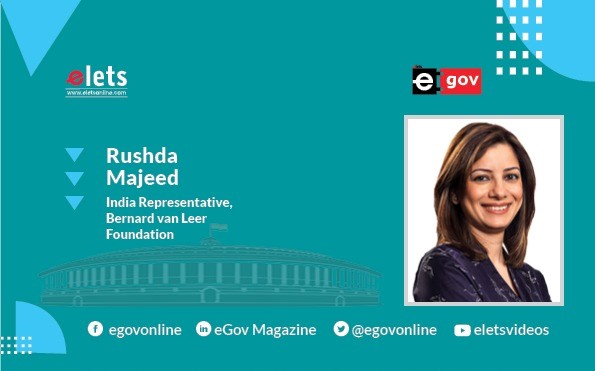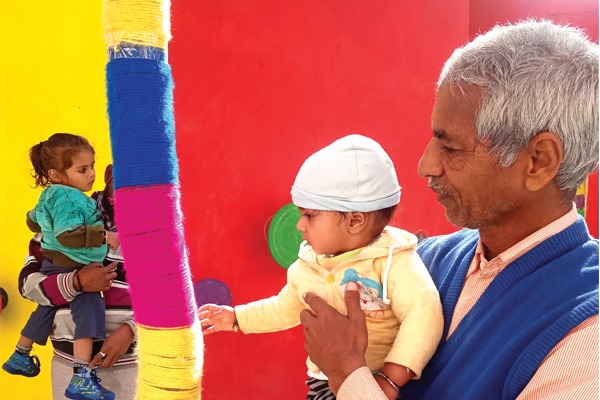
Sustainable Development Goals (SDGs) have a special focus on cities and the exclusive goal of SDG 11.7 is that “by 2030, all countries are to provide universal access to safe, inclusive and accessible, green and public spaces, particularly for women and children, older persons and persons with disabilities.” In this article, Rushda Majeed, India Representative, Bernard van Leer Foundation shares her perspective on the SDG target 11.7 and its implementation in Indian cities.
For Indian cities, the Infant Toddler, Caregiver-Friendly Neighbourhood (ITCN) framework is a key resource for urban local bodies and other stakeholders working towards fulfilling this particular goal. Making public spaces and cities accessible, vibrant, and safer for young children and their caregivers lead to these places being safer for all. Moreover, a focus on infants, toddlers, and caregivers often translates into a focus on inclusivity – in keeping with the goal of 11.b, which is to “increase the number of cities adopting and implementing integrated policies and plans towards inclusion, resource efficiency, mitigation and adaptation to climate change, resilience to disaster.”
Why focus on early childhood and neighbourhood scale?

Substantial research points to the fact that early experiences shape a child’s brain, affecting his or her ability to learn, deal with emotions and challenging situations, and influence overall development. Everyday experiences along with health, nutrition, and responsive care from their caregivers and other family members are major factors in a baby’s holistic development. Providing stimulating and nurturing spaces and experiences help establish brain connections in young children and the right development sets a good foundation for their lifelong health, behaviour, and learning. Children who grow up in the supportive emotional, social, physical, and nurturing environments through access to family-friendly public spaces, nature, and communities get the opportunity to establish good literacy skills, social competence, physical and cognitive abilities, and emotional well-being – for school, work, as well as life. They go on to become healthier, well- adjusted individuals, contributing positively to the society and economy as adults.

Caregiver involvment in stimulating touch and feel_Udaipur Naiyyon ki talai
Achieving SDG 11.7

Traditionally, the approach and process of city planning do not focus on the needs of young children and their families as they are not considered a key stakeholder group. But what urban development professionals and policymakers need to remember is that policies and practices that are friendly towards babies and toddlers, even at the smallest neighbourhood level, works towards building better cities for all age groups as such development does not come at the cost of exclusion of anyone else.
Accomplishing the goals of SDG 11.7 is not without its challenges, especially in the Indian context. Most spaces in the public realm are invariably designed for able-bodied adults. While poorly-lit streets and other areas pose the threat of physical harm and raise safety concerns for women, children, elderly, and people with disabilities, ill- maintained and unequal distribution of parks, necessary amenities, and urban services prevent vulnerable groups from experiencing positive everyday experiences as they try to go about their daily lives. Moreover, high volumes of vehicular traffic, even in neighbourhoods, and haphazard parking are common issues that constantly pose the threat of injury.
Thoughtful urban planning and design can play a major role in addressing such challenges and in giving young children a good start in life and improving the quality of life of all residents, by offering:
● Walkable, mixed-use neighbourhoods that cater for the basic needs of all populations within 15 minutes on foot.
● Safer streets and convenient public transport systems designed to provide accessibility to all and enable residents to conveniently reach wherever they wish to go.
● Healthy, clean environments that improve air quality and contribute to reduced noise pollution levels.
● A vibrant community life that supports the overall well-being of all members of families.
● Lively, nurturing, green spaces that encourage young children to explore and offer pertinent amenities for caregivers.
The dynamism and vibrance of a city are often measured by the presence of young children and families. But what we need to remember is that urban planning that is centred around young children and families go much beyond building a few playgrounds across a city. All families in cities, particularly those living below the poverty line, stand to benefit highly from accessibility to green spaces, clean air and water, convenient public transport, and safe spaces where families can gather and socialise.
Designers, planners, and policymakers can keep the principles of designing cities from an early childhood lens and at neighbourhood- scale as the focus and take inspiration from cities – such as Pune, Udaipur, and Bhubaneswar – that focus on the needs of young children and their caregivers.
The ITCN framework and its relation to SDG 11.7
Launched in partnership with the Ministry of Housing and Urban Affairs (MoHUA), Smart Cities Mission, and Bernard van Leer Foundation, the ITCN Framework and Guidelines comprise five publications that help Indian cities look at urban design, planning and management from early childhood and neighbourhood- scale lens:
● Policy Framework explains the rationale for making changes to improve neighbourhoods and describes the purposes of doing so. This publication thus lays out an overall strategy for building ITC neighbourhoods.
● Design Guidelines provides directions on how key ITCN features can be implemented in public spaces, and how objectives for ITC-friendly can be accomplished.
● Policy Workbook discusses institutional frameworks and links the policy framework to design guidelines. It also lays out challenges that may crop up and ways to address them.
● Evaluation Metrics is a document outlining indicators or Service Level Benchmarks that officials can use to assess existing neighbourhoods from the perspective of ITC friendliness.
● Best Practices Compendium provides helpful examples of successful interventions across Indian and global cities to make public spaces ITC friendly.
A key principle at work here is that cities that are designed for babies, toddlers, and caregivers will improve the quality of life for every person. This aligns with the objective of SDG 11.7, which seeks to make public spaces greener, safer, and more inclusive for not only women and children, but also older persons and persons with disabilities.
A few additional reasons for why an early childhood lens is important in city design:
● Designing for limited mobility: Since infants and toddlers have restricted mobility and slower paces, building neighbourhoods catered to their needs will automatically work towards addressing the basic needs of other vulnerable groups mentioned in SDG 11.7.
● Proximity to essential facilities: Constructing nurturing spaces for vulnerable populations will be a futile exercise if these groups are unable to access such spaces. Locating services like parks, health centres, schools, and basic commercial establishments close to where families reside helps.
● Designing for access: A robust public transport network with frequent services that are accessible for all ages and populations is another important factor to consider while designing cities to fulfil the goals under SDG 11.7.
● Safety and security: Low-traffic zones and infrastructure that makes it safe for young children and their families to walk or cycle, particularly near schools, parks, health and education centres will go a long way in creating cities that are safe and accessible for all.
Conclusion
Mainstreaming an early childhood lens in urban planning and building such infrastructure will work well towards achieving the goals of SDG 11.7, while also improving the overall liveability of cities and the well-being of all residents. In addition, family- friendly public spaces in urban areas can also help boost climate and disaster resilience along with providing economic benefits for the society at large.
Be a part of Elets Collaborative Initiatives. Join Us for Upcoming Events and explore business opportunities. Like us on Facebook , connect with us on LinkedIn and follow us on Twitter, Instagram.











